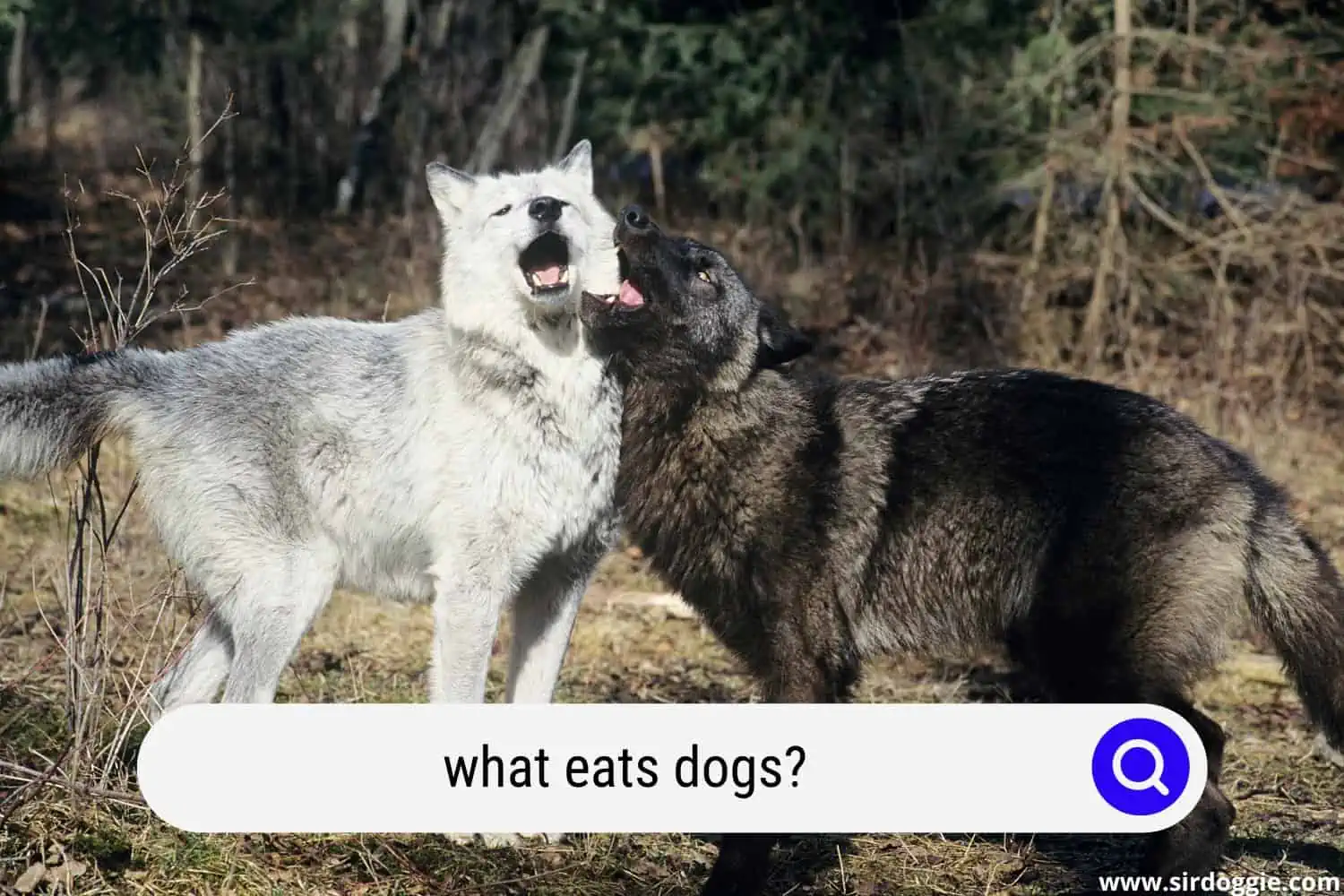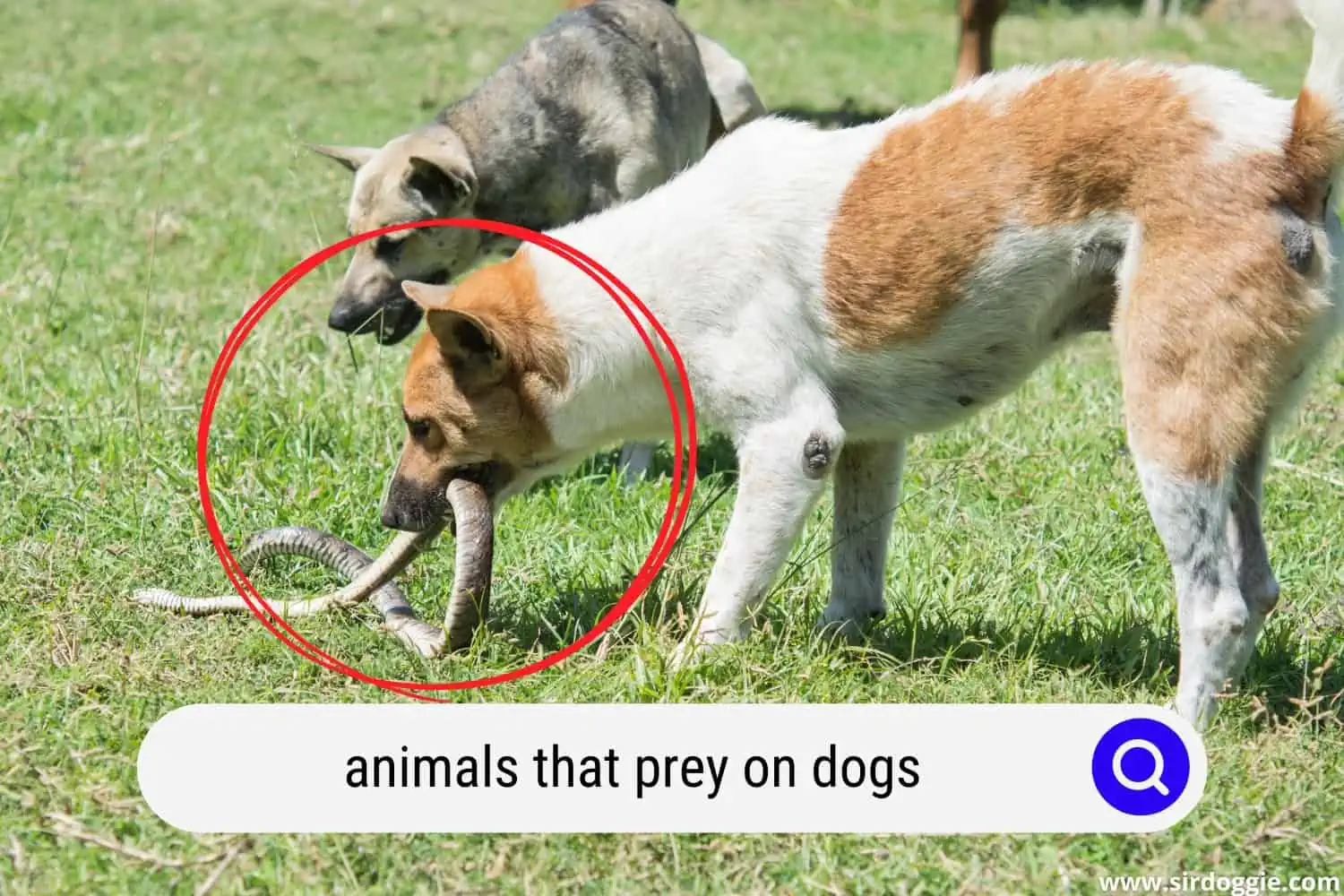What Eats Dogs? (Animals, Nations)
Being aware of the threats your dog may encounter regarding wild animals is an important part of being a responsible pet owner. These hazards are not always confined just to wild areas but may even be found in your backyard. Many predators can kill and eat your canine companions, so let’s discuss these in detail. What eats dogs?
Cougars (mountain lions or pumas), coyotes, gray wolves, large snakes, and humans are the top predators that can eat dogs. Many small dogs are also preyed on by foxes and birds of prey.
Fact: The number of dogs eaten by humans places us at the top of the list of canine hazards.

Animals That Prey on Dogs
Numerous animals prey on dogs. Here are the most common causes of canine death.
Cougars
Cougars, sometimes otherwise known as mountain lions/pumas, are a type of large cat found in various parts of the United States, primarily residing in the western portion of the country. The cougar’s only confirmed population in the eastern United States has been discovered in the state of Florida, where it is referred to as the “Florida Panther.”
Cougars, who were formerly hunted close to extinction, have seen a surge in their population numbers in recent years, and encounters are no longer uncommon. If you reside in a place where these large cats may be found, your outside pets—especially dogs—are at grave risk since dogs are prey to these huge felines. Cougars are more engaged in hunting cattle than they are in hunting pets, but if the opportunity presents itself, they will attack your dog and very likely eat your pup after killing it.
Even though it isn’t typical, cougars have also been known to attack humans as well. If you encounter a cougar on your property, call animal control or the authorities immediately.
Gray Wolves
Gray wolves are found mainly in the Northern United States, especially in Alaska and in Yellowstone National Park. They usually live and attack in packs. These wolves normally do not come near urban areas, but when there are shortages in their usual food supply, they may instead kill and eat domesticated dogs.
Try to be aware of wolves and never engage with them in fighting circumstances (especially if you do not have any firepower) because they always have a pack, and your chances of survival along with your pet may be negligible.
Coyotes
Coyotes can be found all across North America and other parts of the world. Particular portions of the United States have a higher concentration of coyotes than other parts. Because their natural habitat has been repeatedly encroached upon, the coyote has adapted to living in increasingly urban areas and emerging at night when all is calm.
Coyotes have been known to prey on pets, especially small- to medium-sized dogs. It is preferable not to let a dog outside at night and to keep a close check on your dog if you live in a vicinity that has a known coyote presence.
Large Snakes
Snakes are another canine “predator” that can be found throughout North America. Venomous snakes are a more common risk to canines, but in areas such as Florida that have growing larger-sized snake populations emerging, even bigger canines become at risk.
Larger snakes (such as the released Anacondas and Burmese pythons found in Florida) are capable of eating dogs. Smaller but venomous snakes can bite and kill your dog with one strike, and these species are much more common than their large, intimidating counterparts.
Snakes are not antagonistic and don’t go out of their way to attack and kill dogs. In most cases of snake-related canine death, dogs frequently come upon snakes that are resting in burrows, hidden in the grass, or lounging beneath a shelter and disturb them with unfavorable results. When it comes to anything that moves, most canines have a natural fascination for investigation. Snakes desire to be left alone, and when a dog doesn’t take the hint, they will likely get bitten. When a venomous snake is involved, this can easily become fatal. If you reside in Florida and your pup comes across a wild python of significant size, it will simply become dinner.
When strolling, especially in an area with a known snake population or favorable conditions to find any, pet parents should keep a close eye out for danger. Be sure to lease your dog because snake bites are more likely to occur when dogs are not on a leash and allowed to explore a bit too freely. If your dog is playing in the backyard, check on him or her every few minutes or so. If a dog has been bitten, it should be kept as still and as calm as possible to reduce venom circulation until it can be taken to the veterinarian.
Raccoons
Raccoons may appear to be rather innocent and charming compared to larger wild animals, but they are incredibly possessive over their food and may become violent when they feel threatened.
Some raccoons can grow to be as large as a medium-sized dog, and this can make a battle a little more evenly balanced between the two. Raccoons use their claws and teeth as weapons to defend themselves. They may potentially be infected with rabies and other diseases commonly found in wild animals.
It is possible to prevent raccoon occurrences by keeping the lids of garbage cans closed (and weighted with a block, if required) to prevent raccoons from looting your tossed goods and to keep your dogs from going crazy at the furry intruders. Keeping an eye on your pup when he’s outside at night is important because it’s always possible that a large raccoon could be near and engage in a fight and harm your pup.
Bird of Prey
Many birds of prey, such as owls and raptors (eagles, falcons, etc.), target small dogs. Although they may not seem so large since we often just see them at far distances, they are incredibly large birds and can easily kill your tiny canines.
If you’re the pet parent of a puppy or small breed dog, do not leave them outside unattended for any reason. Even if you’re near, these birds are very fast and have been known to abduct and devour smaller pups. If you commonly see hawks or other raptors circling in the sky near where you reside or take your pup to play, exercise extreme caution if your dog is on the smaller side.
The Role of Humans in Eating Dogs
Humans have consumed dog meat in various regions of the world throughout history. Even now, dog meat is still permitted to be used as food and is widely consumed in many nations.
However, as pet ownership has increased, killing and consuming dogs has become much less popular. Additionally, younger generations have developed different attitudes against eating domestic pets.
Which Nations Eat Dogs?
Although dog meat consumption is not considered acceptable in most Western societies, it is still considered normal or even sacred in many other regions of the world. For example, dog meat consumption is regarded as a staple diet in various Asian and African countries, much like beef and turkey in Western societies. Western tourists should exercise caution while attempting traditional cuisine in these nations and should always ask what sort of meat is being served before eating anything if consuming dog meat is a concern to them.
Additionally, dog meat has played an important part in numerous societies throughout history and continues to do so even now. While the ingestion of dog or cat meat may seem strange or even unpleasant to many of us, it is worth noting that other cultures and faiths may have other views. For example, raising cattle for slaughter is considered disgraceful, if not sacrilegious, by the vast majority of Hindus in India or Buddhists in Myanmar. Similarly, the Jains of India are so averse to killing any living creature that they have adopted a specific vegetarian diet.
Despite all these dialogues, here is the list of top countries that eat dog meat regularly:
- China
- South Korea
- North Korea
- Philippines
- Thailand
- Arctic and Antarctic
- Vietnam
- Cambodia
- Laos
- Indonesia
- Taiwan
- Polynesia
- Nigeria
- Liberia
- Ghana
- Cameroon
- Switzerland
- Mexico
- Myanmar

FAQs
Do foxes hunt and eat dogs?
Foxes don’t often hunt and eat dogs, but when they are extremely hungry, they might pose a threat to any domesticated animal that’s tiny enough to be considered a meal.
Do groundhogs eat dogs?
Large rodents such as groundhogs will normally only attack dogs if they feel threatened by your pet. Normally, they do not kill or eat dogs, but they can still harm your canine companions, and they will do so with strong claws and front teeth.
The National Geographic website states that groundhogs are endemic to North America, although they are usually discovered in areas where grassland meets forest. As a result, they are regularly encountered in modern home areas and pose a slight risk to outdoor domesticated animals that may be too curious.
An injury to your dog is almost often the consequence of it getting too near to the groundhog for comfort, which is just another reason why keeping an eye on your pet when outdoors is essential.
What are the most common bird species that can eat dogs?
Below is a list of the three most frequent birds of prey that lash out at tiny dogs and cats, often those weighing less than 20 pounds:
- Red-tailed hawks
- Great horned owls
- Northern goshawks
Can crocodiles eat dogs?
Absolutely. Crocodiles are considered carnivores, meaning they exclusively consume meat/flesh. In the wild, they prey on fish, birds, frogs, crabs, and many other living creatures. While in captivity, crocodiles typically prey on creatures that have already been slaughtered for them, such as rats, fish, and mice. Larger crocodiles may be fed body parts of chicken, turkeys, and other bigger sources of meat.
Crocs have been known to cannibalize one another occasionally, and their encounters with dogs is not often reported because crocodiles and dogs live in totally different habitats. However, if any crocodile were to get the chance to capture and eat a dog, their voracious appetites guarantee they would do so without hesitation nor very much effort.
Do bears eat dogs?
Generally, bears do not eat dogs. In most circumstances, a bear would avoid a conflict with any canine. Although bears can injure and ultimately eat a dog, they would normally just flee the scene of any encounter. However, bears may turn aggressive or violent towards dogs if they believe that the canines are a threat to their newborn cubs. In this type of situation, they are guaranteed to attack and harm a dog, but they may or may not consume the carcass after death.
Related Reading: 10 Animals That Could Attack Your Dog

Family Dog Expert Author
Hi there! I’m Stuart, a devoted dog lover and family dog expert with over a decade of experience working with our furry companions. My passion for dogs drives me to share my knowledge and expertise, helping families build strong, loving bonds with their four-legged friends. When I’m not writing for SirDoggie, you’ll find me hiking, playing with my beautiful dog, or studying music.